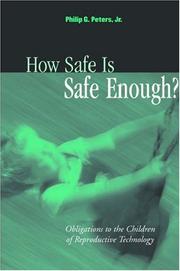| Listing 1 - 1 of 1 |
Sort by
|

ISBN: 1280835605 0199748012 1429438800 9781429438803 9780195157079 0195157079 9781280835605 9786610835607 6610835608 0197707149 0190288973 Year: 2004 Publisher: Oxford New York Oxford University Press
Abstract | Keywords | Export | Availability | Bookmark
 Loading...
Loading...Choose an application
- Reference Manager
- EndNote
- RefWorks (Direct export to RefWorks)
"This book offers a comprehensive road map for determining when and how to regulate risky reproductive technologies on behalf of future children. First, it provides three benchmarks for determining whether a reproductive practice is harmful to the children it produces. This framework synthesizes and extends past efforts to make sense of our intuitive, but paradoxical, belief that reproductive choices can be both life-giving and harmful. Next, it recommends a process for reconciling the interests of future children with the reproductive liberty of prospective parents. The author rejects a blanket preference for either parental autonomy or child welfare and proposes instead a case-by-case inquiry that takes into account the nature and magnitude of the proposed restrictions on procreative liberty, the risk of harm to future children, and the context in which the issue arises. Finally, he applies this framework to four past and future medical treatments with above average risk, including cloning and genetic engineering. Drawing lessons from these case studies, Peters criticizes the current lack of regulatory oversight and recommends both more extensive pre-market testing and closer post-market monitoring of new reproductive technologies. His moderate, pragmatic approach will be widely appreciated."--BOOK JACKET
Reproductive technology --- Human reproductive technology --- Assisted conception --- Assisted human reproduction --- Assisted human reproductive technology --- Conception --- Human assisted reproduction --- Human assisted reproductive technology --- Human reproduction --- Medical technology --- ART (Assisted reproductive technology) --- Assisted reproduction --- Assisted reproductive technology --- Reproduction --- Reproductive techniques --- Biotechnology --- Moral and ethical aspects. --- Political aspects. --- Social aspects. --- Technological innovations
| Listing 1 - 1 of 1 |
Sort by
|

 Search
Search Feedback
Feedback About UniCat
About UniCat  Help
Help News
News